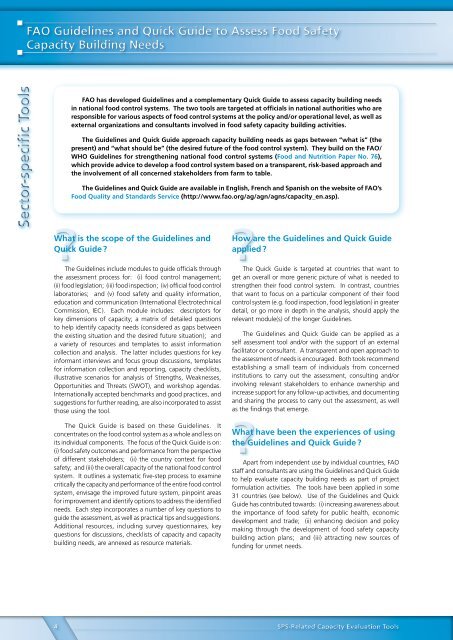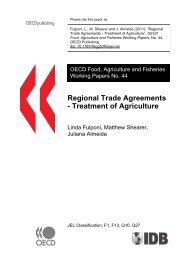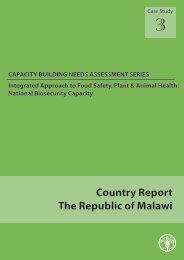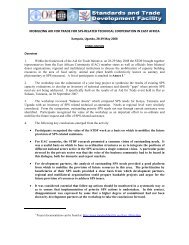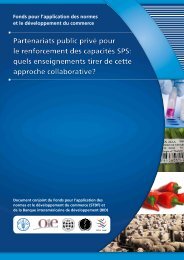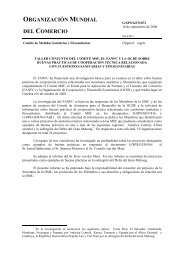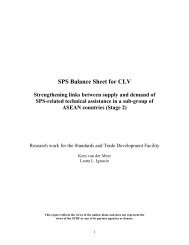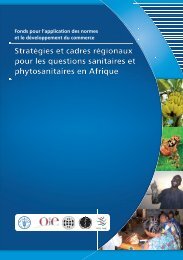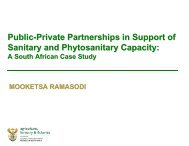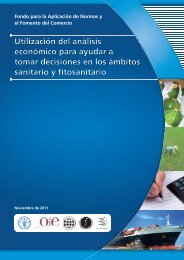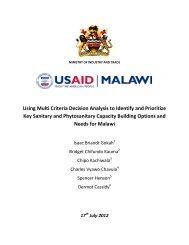SPS-Related Capacity Evaluation Tools - Standards and Trade ...
SPS-Related Capacity Evaluation Tools - Standards and Trade ...
SPS-Related Capacity Evaluation Tools - Standards and Trade ...
You also want an ePaper? Increase the reach of your titles
YUMPU automatically turns print PDFs into web optimized ePapers that Google loves.
Sector-specific <strong>Tools</strong><br />
FAO Guidelines <strong>and</strong> Quick Guide to Assess Food Safety<br />
<strong>Capacity</strong> Building Needs<br />
?<br />
FAO has developed Guidelines <strong>and</strong> a complementary Quick Guide to assess capacity building needs<br />
in national food control systems. The two tools are targeted at officials in national authorities who are<br />
responsible for various aspects of food control systems at the policy <strong>and</strong>/or operational level, as well as<br />
external organizations <strong>and</strong> consultants involved in food safety capacity building activities.<br />
The Guidelines <strong>and</strong> Quick Guide approach capacity building needs as gaps between “what is” (the<br />
present) <strong>and</strong> “what should be” (the desired future of the food control system). They build on the FAO/<br />
WHO Guidelines for strengthening national food control systems (Food <strong>and</strong> Nutrition Paper No. 76),<br />
which provide advice to develop a food control system based on a transparent, risk-based approach <strong>and</strong><br />
the involvement of all concerned stakeholders from farm to table.<br />
The Guidelines <strong>and</strong> Quick Guide are available in English, French <strong>and</strong> Spanish on the website of FAO’s<br />
Food Quality <strong>and</strong> <strong>St<strong>and</strong>ards</strong> Service (http://www.fao.org/ag/agn/agns/capacity_en.asp).<br />
What is the scope of the Guidelines <strong>and</strong><br />
Quick Guide ?<br />
The Guidelines include modules to guide officials through<br />
the assessment process for: (i) food control management;<br />
(ii) food legislation; (iii) food inspection; (iv) official food control<br />
laboratories; <strong>and</strong> (v) food safety <strong>and</strong> quality information,<br />
education <strong>and</strong> communication (International Electrotechnical<br />
Commission, IEC). Each module includes: descriptors for<br />
key dimensions of capacity; a matrix of detailed questions<br />
to help identify capacity needs (considered as gaps between<br />
the existing situation <strong>and</strong> the desired future situation); <strong>and</strong><br />
a variety of resources <strong>and</strong> templates to assist information<br />
collection <strong>and</strong> analysis. The latter includes questions for key<br />
informant interviews <strong>and</strong> focus group discussions, templates<br />
for information collection <strong>and</strong> reporting, capacity checklists,<br />
illustrative scenarios for analysis of Strengths, Weaknesses,<br />
Opportunities <strong>and</strong> Threats (SWOT), <strong>and</strong> workshop agendas.<br />
Internationally accepted benchmarks <strong>and</strong> good practices, <strong>and</strong><br />
suggestions for further reading, are also incorporated to assist<br />
those using the tool.<br />
The Quick Guide is based on these Guidelines. It<br />
concentrates on the food control system as a whole <strong>and</strong> less on<br />
its individual components. The focus of the Quick Guide is on:<br />
(i) food safety outcomes <strong>and</strong> performance from the perspective<br />
of different stakeholders; (ii) the country context for food<br />
safety; <strong>and</strong> (iii) the overall capacity of the national food control<br />
system. It outlines a systematic five-step process to examine<br />
critically the capacity <strong>and</strong> performance of the entire food control<br />
system, envisage the improved future system, pinpoint areas<br />
for improvement <strong>and</strong> identify options to address the identified<br />
needs. Each step incorporates a number of key questions to<br />
guide the assessment, as well as practical tips <strong>and</strong> suggestions.<br />
Additional resources, including survey questionnaires, key<br />
questions for discussions, checklists of capacity <strong>and</strong> capacity<br />
building needs, are annexed as resource materials.<br />
?<br />
How are the Guidelines <strong>and</strong> Quick Guide<br />
applied ?<br />
The Quick Guide is targeted at countries that want to<br />
get an overall or more generic picture of what is needed to<br />
strengthen their food control system. In contrast, countries<br />
that want to focus on a particular component of their food<br />
control system (e.g. food inspection, food legislation) in greater<br />
detail, or go more in depth in the analysis, should apply the<br />
relevant module(s) of the longer Guidelines.<br />
The Guidelines <strong>and</strong> Quick Guide can be applied as a<br />
self assessment tool <strong>and</strong>/or with the support of an external<br />
facilitator or consultant. A transparent <strong>and</strong> open approach to<br />
the assessment of needs is encouraged. Both tools recommend<br />
establishing a small team of individuals from concerned<br />
institutions to carry out the assessment, consulting <strong>and</strong>/or<br />
involving relevant stakeholders to enhance ownership <strong>and</strong><br />
increase support for any follow-up activities, <strong>and</strong> documenting<br />
<strong>and</strong> sharing the process to carry out the assessment, as well<br />
as the findings that emerge.<br />
?<br />
What have been the experiences of using<br />
the Guidelines <strong>and</strong> Quick Guide ?<br />
Apart from independent use by individual countries, FAO<br />
staff <strong>and</strong> consultants are using the Guidelines <strong>and</strong> Quick Guide<br />
to help evaluate capacity building needs as part of project<br />
formulation activities. The tools have been applied in some<br />
31 countries (see below). Use of the Guidelines <strong>and</strong> Quick<br />
Guide has contributed towards: (i) increasing awareness about<br />
the importance of food safety for public health, economic<br />
development <strong>and</strong> trade; (ii) enhancing decision <strong>and</strong> policy<br />
making through the development of food safety capacity<br />
building action plans; <strong>and</strong> (iii) attracting new sources of<br />
funding for unmet needs.<br />
4 <strong>SPS</strong>-<strong>Related</strong> <strong>Capacity</strong> <strong>Evaluation</strong> <strong>Tools</strong>


